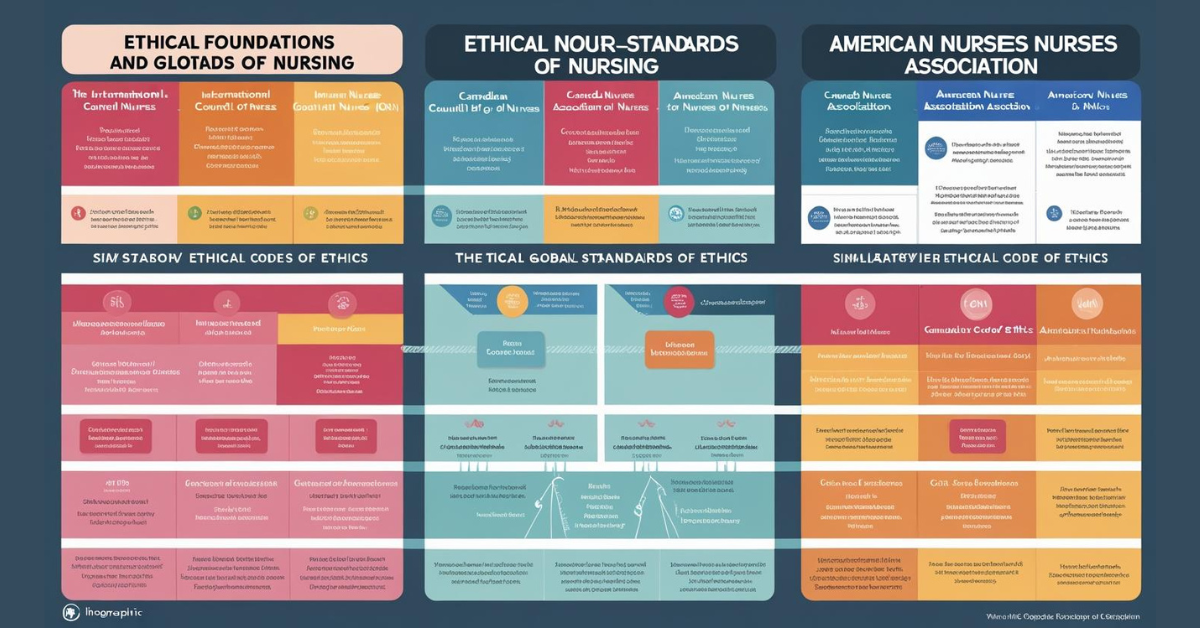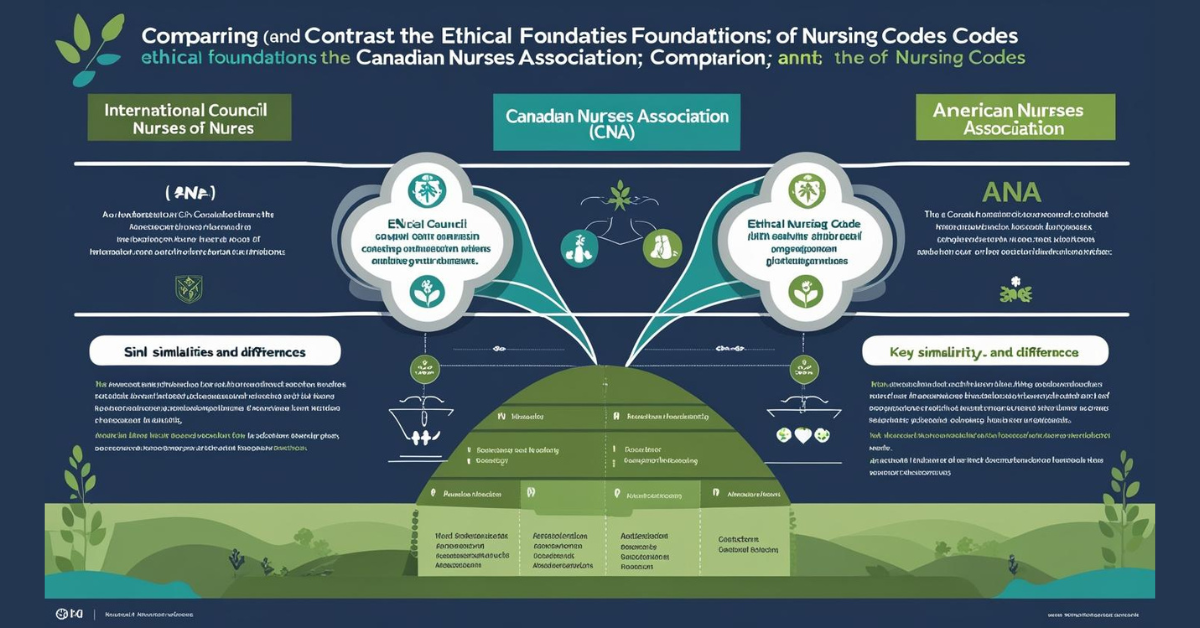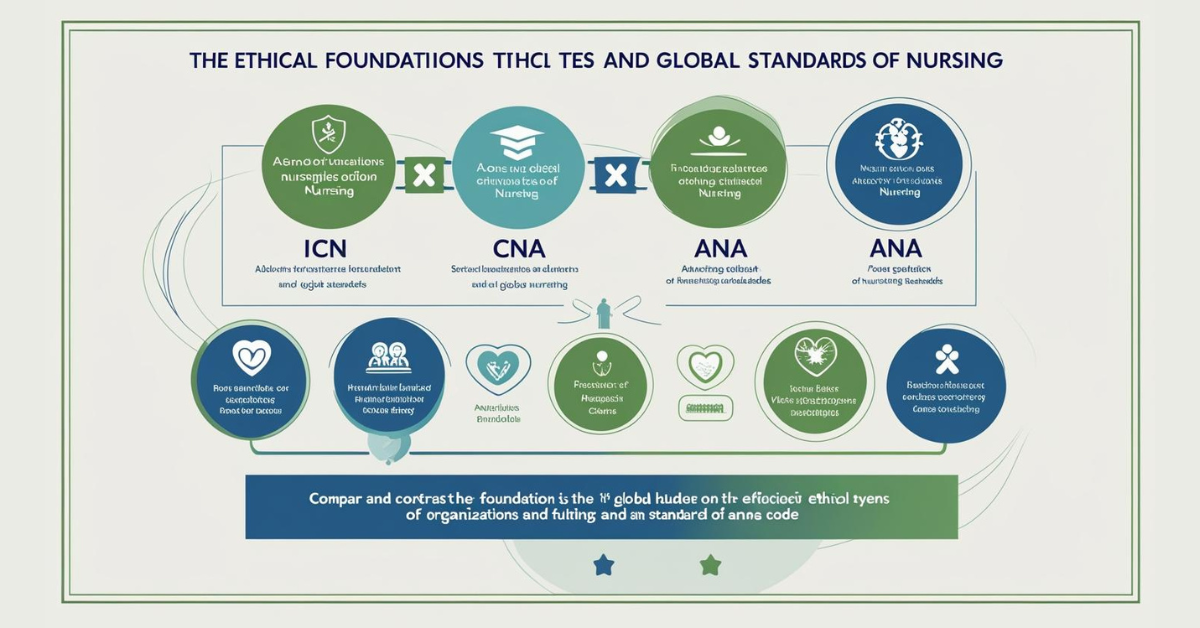What are Global Standards Ethical Foundations in Nursing Comparative Review of ICN CNA and ANA Codes. In nursing, standards of practice play a critical role in ensuring compassionate, high-quality patient care. These standards provide a framework that guides nursing staff in their professional practice and establishes expectations for competence, communication, and ethical behavior.
The Global Standards Ethical Foundations in Nursing Comparative Review of ICN CNA and ANA Codes
One of the main similarities between the ANA and ICN codes is their shared focus on patient dignity and rights. Both codes advocate for patient-centered care and emphasize the importance of the nurse’s role in protecting well-being and rights.
There are four fundamental ethical principles: autonomy, beneficence, justice, and non-maleficence. Every patient has the right to make their own decisions based on their beliefs and values.
It also establishes that a nurse has the right to refuse to participate in a particular decision or action that is morally objectionable, provided that the objection is based on conscience and not on personal preference, prejudice, bias, expediency, or arbitrariness.
The nurse acts in all professional relationships with compassion and respect for the inherent dignity, worth, and uniqueness of each individual, unaffected by considerations of social or economic status, personal characteristics, or the nature of health problems. The ANA advances the nursing profession by promoting high standards of practice, fostering a safe and ethical work environment, improving the health and well-being of nurses, and advocating for health issues of concern to both nurses and the public.
One of the essential similarities between the ANA and ICN codes is their shared focus on the dignity and rights of patients. Both codes promote patient-centered care and emphasize the important role of nurses in protecting the well-being and rights of those in their care.
International Council of Nurses Code of Ethics for Nurses
The ICN Code of Ethics for Nurses was first adopted in 1953 and has been revised numerous times since, most recently in 2012. The purpose of the ICN Code of Ethics for Nurses is to provide “a guide for action based on social values and needs. . . . The Code must be understood, internalized, and used by nurses in all aspects of their work” (ICN, 2012, p. 5).
The ICN Code of Ethics for Nurses recognizes that the need for nursing is universal and delineates four fundamental responsibilities of nurses: “to promote health; to prevent illness; to restore health; and to alleviate suffering” (p. 2). This code of ethics also provides four elements that outline the standards of ethical practice: nurses and people, nurses and practice, nurses and the profession, and nurses and coworkers. It is a global document and, as such, applies to nurses from countries where national nursing organizations are ICN members (Johnstone, 2009).
Canadian Nurses Association Code of Ethics for Registered Nurses
The CNA Code of Ethics for Registered Nurses serves as a foundation for nurses’ ethical practice and provides a statement of ethical values for nurses and their commitment to those with health-care needs and those receiving nursing care.
The CNA’s Code of Ethics is divided into two sections. Part one addresses the core responsibilities central to ethical nursing practice, including providing safe, compassionate, competent, and ethical care; promoting health and well-being; promoting and respecting informed decision making; preserving dignity; maintaining privacy and confidentiality; promoting justice; and being accountable. Part two describes the ethical endeavors that nurses must undertake to address and eliminate social inequities (CNA, 2008).
American Nurses Association Code of Ethics for Nurses With Interpretive Statements
The Nightingale Pledge, drafted in 1893 and modeled after the Hippocratic Oath, was the first code of ethics for nurses (ANA, 2015a). This pledge was revised and adopted as a “tentative code” and published in the American Journal of Nursing in 1940 but was never formally adopted until 1950 as the Code for Professional Nurses. It has been subsequently revised a number of times through the years: in 1956, 1960, 1968, 1976 (at which time it became Code of Ethics for Nurses with Interpretive Statements), 1985, 2001, and most recently in 2015 to reflect the influences of societal changes.
The initial versions of this code of ethics reflected general attitudes toward nursing at the time and included values such as obedience, trustworthiness, loyalty, and adeptness in social etiquette as well as obligations to carry out physicians’ orders (Murray, 2003). Later versions emphasized nurses’ responsibility to the patient, society, and the nursing profession.
Although this code of ethics has evolved over the past century to mirror changes in society, health care, and the nursing profession, it has consistently addressed the fundamental principles of beneficence, non-maleficence, fidelity, and veracity. The Code of Ethics for Nurses establishes ethical standards for the nursing practice and provides a framework to guide nurses in ethical analysis and decision making. Its purpose is threefold (ANA, 2015a, p. viii):
- It is a succinct statement of the ethical obligations and duties of every individual who enters the nursing profession.
- It is the profession’s nonnegotiable ethical standard.
- It is an expression of nursing’s own understanding of its commitment to society.
The current Code of Ethics for Nurses includes nine provisions with related interpretive statements. Provisions one through three address the fundamental values and commitments of the nurse, including dignity and respect for patients; patient rights such as self-determination, safety, privacy, and confidentiality; and acting on questionable practice.
Provisions four through six describe the nurse’s boundaries of duty and loyalty, such as appropriate delegation, accountability, responsibility, maintaining competence, ethical obligations, and integrity. The last three provisions describe the aspects of the nurse’s duties beyond individual patient encounters and include the nurse’s role in the advancement of the profession, responsibilities to the public, and maintaining the integrity of the nursing profession (ANA, 2015a).
The values and obligations addressed in the ANA Code of Ethics for Nurses apply to all nurses in all roles and in all settings (ANA, 2015a). The ethical standards out lined are nonnegotiable, and therefore all nurses are obligated to uphold and adhere to the code (ANA, 1994, 2015a).
Read More:
https://nurseseducator.com/didactic-and-dialectic-teaching-rationale-for-team-based-learning/
https://nurseseducator.com/high-fidelity-simulation-use-in-nursing-education/
First NCLEX Exam Center In Pakistan From Lahore (Mall of Lahore) to the Global Nursing
Categories of Journals: W, X, Y and Z Category Journal In Nursing Education
AI in Healthcare Content Creation: A Double-Edged Sword and Scary
Social Links:
https://www.facebook.com/nurseseducator/
https://www.instagram.com/nurseseducator/
https://www.pinterest.com/NursesEducator/
https://www.linkedin.com/in/nurseseducator/
https://www.researchgate.net/profile/Afza-Lal-Din
https://scholar.google.com/citations?hl=en&user=F0XY9vQAAAAJ



After I originally commented I clicked the -Notify me when new comments are added- checkbox and now each time a comment is added I get four emails with the same comment. Is there any approach you may take away me from that service? Thanks!